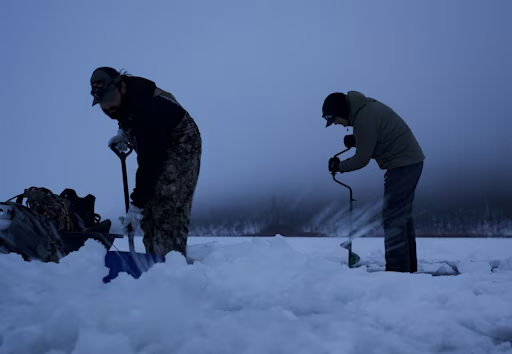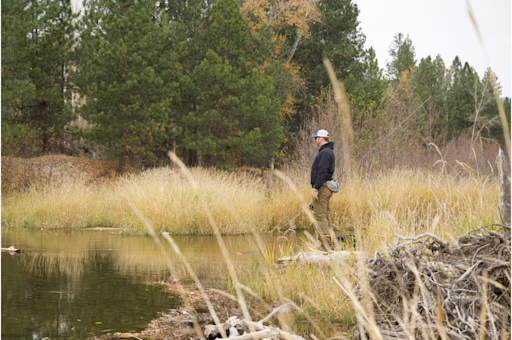Fishbrain's guide to ice fishing
Ice fishing can seem like a daunting hobby to get into, but Fishbrain has the steps necessary for you to get out of your comfort zone and start drilling your first ice hole.
Share this article

Snow and ice cover the lawns, sidewalk and streets in cities across the country. Thick sheets of ice stand between anglers all over the country try and their favorite fishing holes. As anglers, however, we cannot take something as trivial as ice and below freezing temperatures from fishing.
There’s only one solution. It’s time to hit the hard water.
Ice fishing season is in full swing and it is one of the best ways to satisfy your fishing itch, while curing your cabin fever. Ice fishing can seem like a daunting hobby to get into, but Fishbrain has the steps necessary for you to get out of your comfort zone and start drilling your first ice hole.

The basics of ice fishing
Never fish on ice less than four inches thick
Double the above rule if the ice is cloudy, not clear
You'll need an ice rod and reel combo, a shelter and an auger
Bundle up!
The colder it is, the deeper you should fish
Start with ice thickness
Ice fishing always begins with safety and that means measuring the ice thickness. As you make your way onto a lake, or pond you should be measuring the ice thickness every 100, or fewer feet. You should only ever fish on four inches of ice, or more.
Always avoid cracks, fissure and other signs of weakness on the ice and look for clear ice. Clear ice is stronger than cloudy ice because cloudy ice means it has melted and refrozen, which compromises it. If all you see is cloudy ice, double the recommended ice thickness from above.
You should only ever fish on lakes and ponds. Moving water, like rivers and creeks present too much of a danger as the flowing water can cause ice weakness. The current in a river, or creek, can take you under the ice sheet if you do experience a breakthrough.
Here is a quick guide to clear ice thickness and safety according to the Idaho Department of Fish and Game. (We at Fishbrain do not recommend ever driving motor vehicles across the ice, regardless of thickness, however)
4 inches or more = safe for walking on
10 inches or more = small vehicles like snowmobiles, or ATVs
12 inches or more = small trucks and cars
15 inches or more = medium sized trucks

Ice fishing gear
Ice fishing requires specific gear to start, some of which functions in catching fish and the other functions in keeping you on the ice longer.
An auger
Your auger drills through the ice, creating a hole for you to fish in. Augers can be handheld, or gas powered. Your choice of auger type is based on your physical ability to drill your hole, plus the ice thickness you need to get through. If you are going to hit ice fishing hard this year and need to drill multiple holes daily, you may want to consider gas powered.
Ice rod/reel combos
Your standard fishing rod will not do on the ice. Ice rods are very sensitive and short. Fish are moving incredibly slow this time of year and will often take baits gently. Your ice rod will let you feel the slightest of takes from a feeding fish. The short size of the rod will allow you to fish closer to your ice hole and within an ice hut if you have one.
Bait
Artificial lures often require a fish to chase them and just don't cut it during this cold time of year. Maggots, wax worms, minnows, mayfly larvae and other creepy crawlies make for an enticing meal under the ice. Tungsten hooks and jigs are your best bet for ice fishing as you want small hooks that are capable of sinking fast. You will need to figure out the proper depth where fish are feeding and offer very little movement in your hook and bait combo.
Shelters
Newsflash: winter is cold. Having a shelter to keep you out of the cold will keep you fishing longer. Not only that, but having a dark shelter over your ice hole will allow you to see into your ice hole better so you can see bottom structure, depth and any cruising fish. Shelters come in many different sizes fitting a single angler up to five, or six anglers. The larger shelters can be big enough to fit cots and heaters, allowing anglers to fish through the winter nights, even.
Ice skimmers
After you drill a hole in the ice you will have chunks of ice and slush in the water. You need to clear this debris to give you a clean hole to look into and drop your bait into. Skimmers are basically a slotted spoon, picking up the loose ice and letting the water sift through the slots.
Optional (but affective) gear
Tip ups
You can drill multiple holes in the ice and set the hook setting devices around you. When placed, they will set a hook on any fish taking your bait and notify you by raising a flag when the hook is set.
Cameras
Items like Go Fish Cams give you an underwater view of all the fish action. You can see fish cruising, what depths they may be at and how they are interacting with your bait. The underwater view gives you a great perspective of everything under the ice.
Depth/fish finders
They are great tools for judging how deep the water you are standing on is and finding the perfect depth, where fish are living and feeding.

Finding fish in winter
Fishing right after the water ices up to a safe thickness is the best time to fish. Species like trout and panfish will still be relatively near the shore in more shallow waters. As winter goes on, temperatures drop and the ice thickness increases, fish will move into deeper waters, up to around 20 feet and on. A general rule of thumb is the deeper you get into winter, the deeper the fish will be. The warmest water during the cold months will often be found deepest, unlike summer, and fish will move into these depths when the temperatures plummet.
Pro Tip: Fishbrain Pro members can use Garmin Depth Charts to find the exact depths on any lake, or pond. Pairing the depth charts with the outdoor temperature and time of year will allow you to spend more time fishing and less time drilling holes.
Winter is still here and will be for quite some time. The way we at Fishbrain see it, you can either fight it and be miserable, or lean into it and wet a line. Spring fishing will be here before you know it and ice fishing is the perfect activity to practice a new skill and fill your freezer with some delicious fish while you’re at it.
Now let’s go fishing.
If you haven't experienced the #1 fishing app worldwide, make sure and check out Fishbrain to see all the fish data, fishing spots, weather conditions you've been missing out on plus much more.

Download the Fishbrain app and access the best fishing spots in your area
Related blog posts
Master the hardwater season with advanced ice fishing tips . Learn how to find fish faster, refine your search and adjust presentations to catch more fish all winter long.

Your guide to Victoria’s best fish to catch in rivers, lakes, and coastal waters. Learn prime species, fishing tips, and key regulations

Learn how fish adapt as water temperatures cool from autumn to winter, including changes in behavior, metabolism, and habitat that help them survive.




